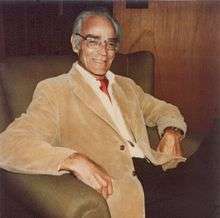Peter Maxwell Ewart
| Peter Maxwell Ewart | |
|---|---|
 c. 1982 | |
| Born |
Peter Maxwell Ewart 7 April 1918 Kisbey, Saskatchewan, Canada |
| Died |
22 January 2001 (aged 82) Langley, British Columbia, Canada |
| Nationality | Canadian |
| Education | Sir George Williams College, Art Association of Montreal, Commercial Illustration Studio of New York City[1] |
| Known for | Painting |
| Spouse(s) | Susan Jane Nickel (1916-1959, m 1957-1959) |
Peter Maxwell Ewart (7 April 1918 – 22 January 2001) was a Canadian painter.
Early life
Born in Kisbey, Saskatchewan, Peter Ewart grew up in Montreal where he moved with his family at the age of two. Thanks to his father, he developed a love of nature in the still-undeveloped woodland outskirts of the city, and became well versed in camping and the out-of-doors. His summers were spent either in Yarker, Ontario, where his father had been raised, or in Barrington, Nova Scotia, where his mother's family had lived for generations. In 1929, he travelled with his father by train to western Canada, cementing his love for the Prairies, the Rockies and the seacoast of British Columbia. It was to be the first of many such trips across the country by train. In 1938, with high school behind him, Peter decided that art was his calling. He completed a correspondence course and then, with a small inheritance from his grandmother, he attended the Commercial Illustration Studio of New York City.[2]
Career
Upon returning to Montreal in 1939, Ewart began to search for work in the art world. He sold his first work to the Exhibits Branch of the Canadian Pacific Railway (CPR) who commissioned him to produce a ski poster in 1939.[3] In the next two decades, he eventually completed 24 posters for CPR and Canadian Pacific Airlines many of which are featured in the book Canadian Pacific Posters 1883–1963, by Marc H. Choko and David L. Jones (Meridian Press).[1]
Wartime brought a desire to enlist and serve in the war effort. In 1943, he joined the RCAF and worked in the manning depot at Lachine, Quebec. That year he also attended wireless school in Saint John, New Brunswick. His basic training completed, he waited for a posting to #1 Wireless School in Montreal. As a wireless operator he was assigned to Calgary, Alberta, and then was stationed at the air force base at Patricia Bay on Vancouver Island. From there, in 1945, he was sent for a year's assignment as a radar technician to Spider Island, just northwest of Ocean Falls, BC. When not on duty he drew many plein air sketches of the coast and ocean, many of which were the source of seascapes created on his return to Montreal.[4]
Exhibitions
- Alex Fraser Galleries, Vancouver[2]
- Royal Canadian Academy[2]
- Royal Academy (London, England)[5]
- Canadian National Exhibition (Toronto)[2]
- Mid-Century Exposition of Canadian Painting[2]
- Calgary Stampede (1967)[2]
- Alwin Galleries (London, England 1972)[2]
- Sheck and Gainsborough Galleries, Calgary[6]
- Downstairs Gallery, Edmonton[6]
- Harrison Galleries, Granville, Vancouver[6]
- Humberston Edwards Fine Art, West Vancouver[6]
- Daniel Izzard's Gallery of the Golden Key, Vancouver[6]
- Jack Hambleton Galleries, Kelowna, BC[6]
- Pegasus Gallery, Salt Spring Island[6]
Works in other media
Peter Ewart was a successful poster artist, creating a series of 24 for Canadian Pacific Railway and Canadian Pacific Airlines.
References
- 1 2 Choko, Marc H. and Jones, David L. (1990). Canadian Pacific Posters 1883–1963. Montreal: Meridian Press.
- 1 2 3 4 5 6 7 Peter Ewart, Odon Wagner Gallery
- ↑ Peter Ewart (1918–2001)
- ↑ 1940-1944, Peter Ewart, an artist's journey
- ↑ Peter Ewart, Saskatchewan NAC
- 1 2 3 4 5 6 7 The Langley Years, Peter Ewart (1918-2001) - A Retrospective.
External links
- Peter Ewart, Pegasus Gallery
- Peter Ewart (1918-2001) – A Retrospective, peterewart.com